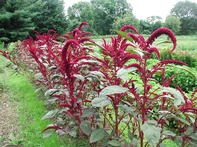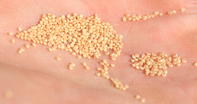Amaranth, (the Amaranthus species) also known as pigweed, cockscomb and hell’s curse in English, is both a common weed as well as an ancient crop. Technically not a cereal grain, but used like one.

Amaranth is used for its fresh leaves, protein-rich seeds and seeds ground into a gluten-free flour. It was used as far back as 6 700 BC by the Aztecs in South America.
The different species originated in different countries, but it is believed that A. spinosus and A. thunbergia are native to Africa. Amaranth is a fast-growing annual with bushy flower heads. It loves high temperatures and can grow up to 2 m in height.
There are over 60 species of amaranth - some types are grown for seed production, while others are grown for their edible leaves. The leaves and the seeds are used for human consumption, but the whole plant can be used for animal feed.
The green types are less bitter than the reddish ones. Grain amaranths can grow between 30 cm and 2 m tall, vary in flower, leaf and stem colour, but the purple and red colouring are common in all three plant parts. Seeds are tiny (3 000 seeds per gram) and black in colour except in the grain varieties where the seeds are cream-coloured.
Growing Amaranth

Amaranth is not widely cultivated in South Africa; it is mostly harvested from the wild when it appears after the first rains. South African research on amaranth in cultivated conditions, shows amaranth producing fresh leaf yields of up to 40 t/ha.
The yield of grain amaranth varies but 1 ton/ha is considered a good yield. Amaranth prefers the heat (above 25℃) of the summer rainfall provinces of Limpopo, Mpumalanga, KwaZulu-Natal and the North West. It is drought tolerant and does not like waterlogged soils. Amaranth is best propagated from seeds - sowing about 270 kg/ha is best.
Mix the seed with soil at a ratio of 1: 2 and broadcast or sow in rows about 1 cm deep. Rows should be 1 m apart. In smaller plots, prepare the soil by adding a bucket of cow or chicken manure per 1 m² of soil. Amaranth grows slowly during the first few weeks and may be overtaken by weeds.
Good weed control can also prevent other problems as weeds act as a host for pests and diseases. Organic pesticides; for example, Neem products might help. The first cutting of amaranth leaves can yield 1.0-1.5 kg/m² and continuous cropping may yield up to 30 kg/m² marketable product per year. More frequent cuttings increase both yield and quality of leaves.
Yield increases in loose, well-composted soils with a pH of around 6.4. Nitrogen is essential for the regrowth of leaves after harvesting. Commercial farmers may use cow manure at 6 tons/ha or commercial fertilisers with a high nitrogen content.
Harvesting Amaranth
The crop can be harvested in two ways - the whole plant can be cut at 20 cm growth or it can be left to grow for the leaves to be hand-harvested at regular intervals. Remove growth points and flowers to encourage leaf growth. A fast grower, amaranth may be harvested from 30 to 55 days after sowing. Amaranth seeds are harvested when the leaves turn yellow.
It is best to harvest after a severe frost or after a week of drought to ensure seeds are thoroughly dry. Seedheads are cup by hand and dropped into buckets.
Harvested seeds are then dried on a plastic sheet in the shade and should be screened (to separate the seeds from the chaff), graded and packed as soon as it’s dried to about 11% moisture. Internationally, commercial production of amaranth occurs in India, China, Southeast Asia, Mexico, the Andes mountains and the United States where harvesting is done mechanically.
By Marinda Louw